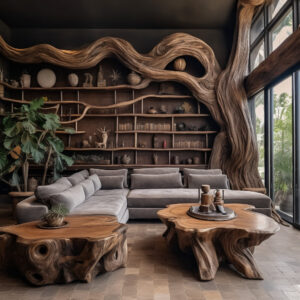The Future of Smart Home Technologies: Revolutionizing Your Living Space
From voice-activated assistants to automated lighting systems, the integration of smart home technologies is rapidly redefining the concept of a comfortable and aesthetically pleasing living space. As technology continues to evolve, so do the opportunities for homeowners to enhance their environments to be more efficient, secure, and reflective of their personal style. In this blog post, we’ll dive into the core elements of interior design while seamlessly blending in the cutting-edge world of smart home innovations.
Introduction
As we step into the future, our homes are becoming more than just dwellings; they are bastions of technology that offer unparalleled comfort, convenience, and style. Smart Home Technologies, which include an array of devices designed to interact and adapt to our daily lives, have the power to transform ordinary spaces into extraordinary experiences. Imagine living in an environment that caters to your every need with the mere whisper of a command, that learns your preferences, and even anticipates your desires. This is not a futuristic dream—it’s the reality that modern interior design, powered by Smart Home Technologies, offers.
Key Elements
To create an interior that’s both visually stunning and technologically advanced, you must master several key elements. These components serve as the foundation of any well-designed space, which becomes even more dynamic with the integration of Smart Home Technologies.
Element 1: Color Palettes
Color influences not only the aesthetics of a room but also the mood and psychological comfort of its inhabitants. When harmoniously integrated with smart lighting solutions, color palettes can be infinitely adaptable, creating ambiance and enhancing the functionality of a space. Smart LEDs, for instance, can transition from vibrant to soft hues to complement the time of day or setting.
Element 2: Furniture Arrangement
Furniture should be selected and arranged in a way that maximizes space, encourages flow, and serves purpose. Smart furniture pieces, like couches with built-in charging ports or coffee tables with hidden compartments for your gadgets, are becoming staples in the tech-savvy household. Arrangement is also digitally augmented with apps that help visualize furniture placement before making any heavy lifts.
Element 3: Lighting
Lighting is no longer just about fixtures—it’s an integral part of home automation. Smart lighting systems can be controlled via apps or voice commands, adjusting in brightness and color to suit any occasion or time of day. These intelligent systems can also learn from your habits, ensuring that your home is always illuminated to your liking.
Element 4: Accessories
Accessories give a home its unique character. With Smart Home Technologies, accessories can also serve as functional elements. From digital art frames that display a rotating collection of your favorite pieces to smart vases that remind you when to water your plants, the possibilities for smart accessories are endless.
Tips for Smart Home Technologies
- Prioritize Compatibility:
Ensure that your smart home devices can communicate with each other by selecting products that are compatible or that can be integrated through a central home automation hub. - Consider Aesthetics with Tech:
Choose smart devices that blend in with your interior theme. Today, many smart home technologies come with customizable appearances or discreet designs that won’t disrupt your decor. - Functionality Meets Style:
Evaluate the practical needs of your space. A well-designed room with smart tech should look great but also solve lifestyle challenges, like a smart sofa with built-in speakers for small apartments lacking audio system space.
FAQ about Smart Home Technologies
Question 1: What is the first step in creating a smart home integrated with interior design?
– Answer: The first step is to determine your needs and goals. Assess what smart home technologies can enhance your lifestyle, and then consider how these can be incorporated into your existing or planned design aesthetic.
Question 2: How can smart home technologies help in energy conservation?
– Answer: Smart home devices like thermostats, blinds, and lighting systems can be programmed or learn to optimize energy usage. They can adjust settings based on presence or absence in the room, time of day, and even weather conditions to reduce unnecessary energy consumption.
Question 3: Can smart technology improve home security?
– Answer: Absolutely. Smart locks, security cameras, and alarm systems can all be controlled remotely and can send alerts to your devices, providing real-time security updates. Modern systems can also use facial recognition, enhancing both convenience and safety.
Question 4: Are smart homes a good investment?
– Answer: Smart homes are generally considered a good investment as they can enhance property value by offering cutting-edge technology that improves convenience, security, and energy efficiency, which are attractive features for future buyers.
Question 5: How do I choose the right smart home technology for each room?
– Answer: Consider the function of each room. For a kitchen, you might prioritize smart appliances, while a bedroom might benefit more from smart lighting and temperature control. It’s important to select technologies that will enhance the room’s primary use and your lifestyle.
In conclusion, the integration of Smart Home Technologies within interior design is not just about adopting the latest gadgets—it’s about creating a harmonious blend of comfort, convenience, and personal expression. As we forge ahead into an era where technology and design are inextricable, the possibilities for innovation within our homes are boundless. Embrace these changes, and you’ll be able to craft a living space that is truly responsive to the rhythms of your daily life, impressing not just with its aesthetics but with its intelligence as well.




